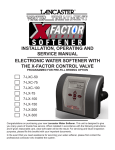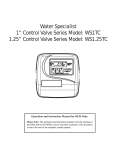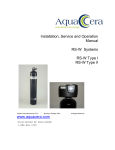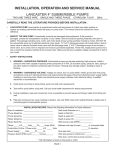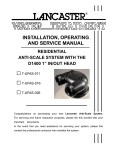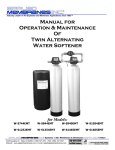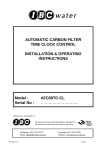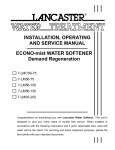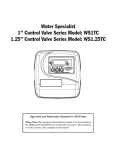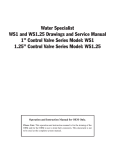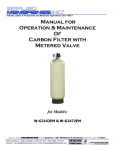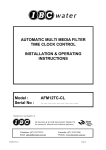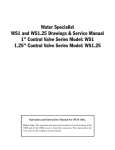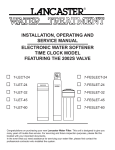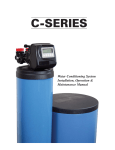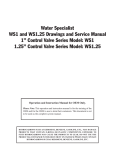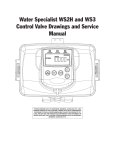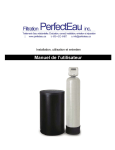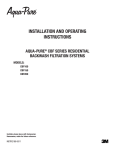Download LETPIM Greensand Filter.pub
Transcript
INSTALLATION, OPERATING AND SERVICE MANUAL ELECTRONIC IRON FILTER TIME CLOCK MODEL FEATURING THE 2002S VALVE 7-LETPIM-1 7-LETPIM-2 7-LETPIM-3 Congratulations on purchasing your new Lancaster Iron Filter. This unit is designed to give you many years of trouble free service. When installed in accordance with the following instructions and if given reasonable care, better water quality will be the result. For servicing and future inspection purposes, please file this booklet with your important documents. OPERATING PARAMETERS Minimum / Maximum Operating Pressures 20 psi (138 kPa) - 125 psi (862 kPa) Minimum / Maximum Operating Temperatures 40°F (4°C) - 110°F (38°C) Current Draw & Voltage 0.5 Amperes - 110 Volts Other Options Available GENERAL WARNINGS The control valve, fittings and/or bypass are designed to accommodate minor plumbing misalignments but are not designed to support the weight of a system or the plumbing. DO NOT use Vaseline, oils, other hydrocarbon lubrications or spray silicone anywhere. A silicone lubricant may be used on black o-rings but is not necessary. Avoid any type of lubricants, including silicone, on red or clear lip seals. The nuts and caps are designed to be unscrewed or tightened by hand or with the optional maintenance wrench (p/n V3193). If necessary, pliers can be used to unscrew the nut or cap. DO NOT use a pipe wrench to tighten or loosen nuts or caps. DO NOT place screwdriver in slots on caps and/or tap with a hammer. Do not use pipe dope or any other sealant on threads. Teflon tape must be used on the threads of the 1” NPT elbow or the 1/4” NPT connection and on the threads for the drain line connection. Teflon tape is not necessary on the nut connection or caps because of o-ring seals. After completing any valve maintenance involving the drive assembly and pistons, unplug power source jack from the printed circuit (PC) board (black wire) and plug back in. This resets the electronics and establishes the service position. All plumbing should be done in accordance with local plumbing codes. The pipe size of the drain line should be a minimum of 1/2”. Backwash flow rates in excess of 7 gpm or length in excess of 20’ require 3/4” drain line. Solder joints near the drain must be done prior to connecting the drain line flow control fitting. Leave at least 6” between the drain line control and fitting solder joints when soldering pipes that are connected on the drain line control fitting. Failure to do this could cause interior damage to the drain line flow control fitting. When assembling the installation fitting package p/n V3007 (inlet and outlet - see page 10), connect the fitting to the plumbing system first and then attach the nut, split ring and o-ring. Heat from soldering or solvent cements may damage the nut, split ring or o-ring. Solder joints should be cool and solvent cements should be set before installing the nut, split ring and o-ring. Avoid getting primer and solvent cement on any part of the o-rings, split rings, bypass valve or control valve. Plug into an electrical outlet. NOTE: All electrical connections must be connected according to local codes. (Be certain the outlet is uninterrupted.) Install grounding strap on metal pipes. PRIOR TO INSTALLATION: Oxidizing filters (iron, manganese, hydrogen sulfide) require a neutral or greater pH for proper chemical reaction. For iron and hydrogen sulfide a pH of at least 7 is required; manganese may require a pH of 8. If pH correction is required, a chemical feed pump (soda ash) is recommended. PH correction is done prior to the oxidizing filter. INSTALLATION ADD MINERALS: Remove control valve from mineral tank by turning counter-clockwise. Plug open end (top) of distributor tube assembly to prevent gravel & mineral from entering (Fig. 1). Keeping distributor in place at the bottom center of the tank, add gravel support bed. It is important that the distributor assembly be centered and touching the bottom of the tank to insure proper fit into the valve. Add mineral on top of gravel support bed. DO NOT OVERFILL. There must be at least 16” of space between the top of the tank and mineral (Fig. 2). Remove plug from the top of the distributor tube. Install control valve making sure the distributor tube is slipped into the center hole on the bottom of the control valve. 2 FIGURE A Place filter in desired location close to water supply inlet, after pressure tank, and near a source for waste water, (utility sink, floor drain or sewer line). A 115/120V, 60 Hz uninterrupted outlet is required. Keep filter far enough away from walls and other obstructions to allow enough room for servicing the unit. All sillcocks and similar fixtures that will use untreated water must have their pipes connected to the untreated water side of the filter. A bypass valve (optional accessory) should be installed so that water will be available if it should be necessary to shut off the pressure in order to service the filter. The mineral tank must be reasonably level and solidly in place. Prior to beginning work to the system, make sure that water pressure is shut off at the incoming water supply and that several water spigots are open to provide sufficient venting for drainage of that system. Arrows are molded into the control valve to show the direction of the flow. OPTIONAL BYPASS VALVE: The bypass valve easily connects to the control valve body using nuts that only require hand tightening. Install with red knobs in the upward position. Press end of bypass valve with o-rings into valve. Hand tighten nuts. Place into BYPASS OPERATION (figure A). Avoid getting primer and solvent cement on any part of the o-rings or split rings, bypass valve or control valve. DO NOT use pipe dope or any other sealant on threads. Teflon tape is not necessary on the caps because of o-ring seals. DO NOT use Vaseline or other unacceptable lubricants on o-rings. A silicone lubricant may be used on black o-rings. DRAIN LINE: The 3/4” drain line elbow accommodates 5/8” poly tube or 3/4” NPT drain line connections. The nut and poly tube insert for the 3/4” drain line elbow is designed for use with flexible poly tube only. The drain line elbow can be rotated so the outlet can be oriented toward the nearest drain. 3 TO INSTALL 5/8” POLY TUBE DRAIN LINE: The poly tube insert is shipped attached to the drain line elbow’s locking clip. Press the insert into the drain line (5/8” poly tube not included). Loosen nut of the drain line elbow. Press 5/8” poly tube with insert into the drain line elbow until it seats on the back of the fitting. Tighten nut. It is simplest to run the drain line into a sump pump pit or washing machine drain if possible. If this is not practical, a fitting with a trap must be installed in a sewer line. Place the trap as close to the vent as possible to prevent siphoning of the trap when large amounts of waste water go through the sewer line. DO NOT pipe the drain line solidly into the waste line, as this is prohibited by most plumbing codes. The drain line should enter the trap from above so the water will not back up in the drain line if sewer should become plugged up and the trap overflow. The trap should have a short pipe extending from it to prevent splashing when water runs into the trap from drain line. SOLUTION TANK CONNECTIONS: 3/8” poly tube is shipped inside of the solution tank. The poly tube insert to be used on the control valve fitting is shipped on the regenerant line elbow’s locking clip. Remove the locking clip by pulling straight out. Remove the white poly tube insert from the locking clip, and replace the locking clip on the regenerant line elbow of the control valve. Press the poly tube insert into the provided 3/8” poly tube. Press the poly tube and insert into the nut until it is fully seated into the fitting. DO NOT use pipe dope or any other sealant on threads. Teflon tape is not needed on the threads. Tighten nut securely to create a pressure tight connection. Pliers or crescent wrench may be used. The nut, gripper and retainer sleeve is a three piece assembly that can come apart if removed from the elbow body. Parts must be reassembled exactly as shown to function properly. If the nut is completely removed from the The poly tube insert used for the solution tank fitting is in an envelope inside of the solution tank. PROGRAMMING THE CONTROL VALVE: Note: A quick-reference card is stored inside the front cover of the control valve. To access this card, slightly pull tabs on side of cover outward and pull cover forward. Plug the electrical cord into a 115 Volt receptacle. DO NOT plug into an outlet controlled by a wall switch or pull chain that could inadvertently be turned off. Wait a couple of seconds for control valve to “home” itself. The time of day will be flashing, an arrow will be pointing to “Time-Hour”. SET TIME OF DAY STEP 1: Press and release SET HOUR. STEP 2: Set current time. Set the clock to the closest hour by using the ▲ or ▼ buttons. An arrow points to PM after 12. Press SET HOUR to exit. POWER LOSS: If the power goes out, current time of day will need to be reset. If the power goes out while the system is regenerating, the cycle picks up where it was interrupted when the power returns. Note: The display will flash if a power outage has occurred. 4 SET REGENERATION TIME AND DAYS BETWEEN REGENERATIONS: STEP 1: From normal mode, press SET HOUR + ▲ buttons simultaneously for three (3) seconds and release STEP 2: Regeneration Time: Set the clock to the hour the regeneration should occur by using the ▲ or ▼buttons. An arrow points to PM after 12. Press SET HOUR to go to STEP 3 STEP 3: Days To Regen: Set the number of days between regenerations by using the ▲ or ▼ buttons. The allowable range is 1 to 99. Press SET HOUR to exit. USE CHART ON OPPOSITE PAGE TO DETERMINE REGENERATION INTERVAL. PLACING UNIT INTO SERVICE: Make sure inlet and outlet valves are to their closed positions. If using optional bypass, place in bypass position. Turn on main water supply. Open a cold water faucet. This will clear the lines of any debris (solder, pipe dope, etc.) that may be in the line. Let water run at tap for a couple of minutes, or until clear. Turn off faucet. Manually add 1 inch of water to the solution tank. • • • • Press and hold the ▲ and▼ buttons simultaneously for approximately 5 seconds until the motor starts. Wait until display reads C1. This is the first BACKWASH position. Momentarily press ▲ button. Display will read C2. This is the BRINE & RINSE position. Momentarily press ▲ button again. Valve is now in the second BACKWASH position, C3. □ If using optional bypass SLOWLY turn bypass valve to DIAGNOSTIC position (figure B) or slowly open inlet valve to allow water to slowly enter the filter. □ When water is flowing steadily to drain without the presence of air, and no more "fines" are seen, momentarily press ▲ button again. Display will read C4. This is the final rinse position. □ Open the outlet valve of the filter, or if using optional bypass place to NORMAL OPERATION MODE (figure C). □ Allow control to finish the FINAL RINSE cycle (C4). It will then advance to the FILL position (C5). The solution tank will now automatically fill with the proper volume of water for the first regeneration. □ Allow the control to automatically advance to the SOFTENING position. C0 will appear for a few seconds, the unit will then display the time of day. □ Pour granulated potassium permanganate into tank and secure cover with screws provided. The greensand filter must be regenerated with potassium permanganate before being placed into service. Press and hold the ▲ and▼ buttons simultaneously for approximately 5 seconds until the motor starts. Allow control to cycle through the entire regeneration process. DIAGNOSTIC MODE NORMAL OPERATION MODE FIGURE B 5 FIGURE C OPTIONAL MAINTENANCE WRENCH Part Number V3193 MUST KNOW: ♦ Amount of iron, manganese or in PPM or mg/L ♦ Approximate daily water usage in gallons hydrogen sulfide Although no tools are necessary to assemble MAXIMUM REMOVAL CAPACITY PER CUBIC FOOT: A mixture of elethe valve, the optional maintenance wrench ments may be removed but total capacity may not exceed 10,000 PPM per cubic foot and may be less depending on mixture proportions. (shown in various positions on the valve) may be purchased to aid in assembly or ♦ Iron: 10,000 PPM or mg/L disassembly. ♦ Manganese: 5,000 PPM or mg/L ♦ Hydrogen Sulfide: 2,000 PPM or mg/L REGENERATION FREQUENCY Gallons per day x PPM = PPM per day Example: 300 gallons x 5 PPM = 1500PPM 1 cubic foot capacity if iron= 10,000 PPM 10,000 1500 = 6 2/3 days (Set for maximum of 6 day cycle) OPERATING LIMITATION: ♦ Iron or Manganese: no more than 15 PPM ♦ Hydrogen Sulfide: no more than 5 PPM ♦ pH: 6.2 to 8.5 For full capacity a pH of at least 7 is recommended. It is particularly important that low pH water be avoided and that regeneration be initiated before bed exhaustion in water containing hydrogen sulfide or sulfur compounds. Failure to do this may cause the manganese oxide coating on the base material to be dissolved and the filter bed ruined. Leaching of manganese oxide from the bed may also occur if inadequate amounts of potassium permanganate are dissolved due to unusually low temperatures in the solution tank or if excessive time between regeneration cycles is attempted. The float level in the solution tank is calibrated for 50º operation. Extremely cold temperatures (35º) will cause partial regeneration due to low solubility, high temperatures (75º) will waste potassium permanganate due to high solubility. Operating results when organic materials such as tannins are present are unpredictable. Organic material is generally not removable with this equipment, and may prevent effective oxidation and filtration of iron, etc. 6 ADDITIONAL PROGRAMMING INFORMATION AVAILABLE FROM LANCASTER WATER TREATMENT UPON REQUEST. INCLUDES: 7-DAY OPTION, REGENERATION CYCLES, TIMES AND 50 Hz. SERVICE INSTRUCTIONS DRIVE ASSEMBLY: Remove the valve cover to access the drive assembly. Disconnect the power source plug (black wire) from the PC board prior to disconnecting the motor plug from the PC board. The motor plug connects to the two-pin jack on the left-hand side of the PC board. The power source plug connects to the four-pin jack. The PC board can be removed separately from the drive bracket but it is not recommended. Do not attempt to remove the display panel from the PC board. Handle the board by the edges. To remove the PC board from the drive bracket, unplug the power and motor plugs from the PC board. Lift the middle latch along the top of the drive bracket while pulling outward on the top of the PC board. The drive bracket has one plastic pin that fits into the hole in the lower edge of the PC board. Once the PC board is tilted about 45° from the drive bracket it can be lifted off the pin. To reinstall the PC board, position the lower edge of the PC board so that the hole in the PC board lines up with the plastic pin. Push the top of the PC board towards the valve. Align the upper hole on the left hand side of the PC board with the pin and push in until the PC board snaps under the middle latch, weave the power wire into the holders and reconnect the motor and power plugs. The drive bracket must be removed to access the drive cap assembly and pistons or the drive gear cover. It is not necessary to remove the PC board from the drive bracket to remove the drive bracket. To remove the drive bracket start by removing the plug for the power source. Unweave the wire from the side holders. Two tabs on the top of the drive back plate hold the drive bracket in place. Simultaneously lift the two tabs and gently ease the top of the drive bracket toward your body. The lower edge of the drive bracket has two notches that rest on the drive back plate. Lift up and outward on the drive bracket to disengage the notches. To reassemble seat the bottom of the drive bracket so the notches are engaged at the bottom of the drive back plate. Push the top of the drive bracket towards the two latches. The drive bracket may have to be lifted slightly to let the threaded piston rod pass through the hole in the drive bracket. Maintain a slight engaging force on the top of the drive bracket while deflecting the bracket slightly to the left by pressing on the side of the upper right corner. This helps the drive gears mesh with the drive cap assembly. The drive bracket is properly seated when it snaps under the latches on the drive back plate. If resistance is felt before latching, then the notches are not fully engaged, the piston rod is not in the hole, the power wire is jammed between the drive bracket and the drive plate, or the gear is not engaging the drive cap assembly. To inspect drive gears, the drive gear cover needs to be removed. The drive gear is held in place on the drive bracket by three clips. The largest of the three clips is always oriented to the bottom of the drive bracket. Before trying to remove the drive gear cover, the drive bracket must be removed from the drive back plate. The drive gear cover can be removed from the drive bracket without removing the PC board. Simultaneously, push in and down on the large clip at the bottom and the clip on the left-hand side of the drive bracket behind the PC board. Keep your other fingers behind the drive gear cover so the drive gears do not drop on the ground. Replace broken or damaged drive gears. Do not lubricate any of the gears. Avoid getting any foreign matter on the reflective coating because dirt or oils may interfere with pulse counting. The drive gear cover only fits on one way, with the large clip oriented towards the bottom. If all three clips are outside of the gear shroud on the drive bracket the drive gear cover slips easily into place. The drive bracket does not need to be removed from the drive plate if the motor needs to be removed. To remove the motor, disconnect the power and motor plugs from the jacks on the PC board. Move the spring clip loop to the right and hold. Rotate the motor at least a ¼ turn in either direction before gently pulling on the wire connectors to remove the motor. Pulling directly on the wire without rotating the motor may break the wires off the motor. Replace the motor if necessary. Do not lubricate the motor or the gears. When reinstalling the motor gently turn the motor while inserting so that the gear on the motor meshes with the gears under the drive gear cover and the small plastic plug engages one of the slots on the motor housing. Reconnect the motor plug to the two pronged jack on the lower left-hand side of the PC board. If the motor will not easily engage with the drive gear when reinstalling, lift and slightly rotate motor before reinserting. Replace the valve cover. After completing any valve maintenance, press and hold SET HOUR and ▼ buttons for 5 seconds or unplug power source jack (black wire) from the circuit board and plug back in. This resets the electronics and establishes the home position for softening. Reset the time of day. 7 DRIVE CAP ASSEMBLY, MAIN PISTON AND REGENERANT PISTON: The drive assembly must be removed to access the drive cap assembly. The drive cap assembly must be removed to access the piston(s). The drive cap assembly is threaded into the control valve body and seals the o-ring. To remove the drive cap assembly use the optional maintenance wrench or insert a ¼” to ½” flat bladed screwdriver into one the slots around the top 2” of the drive cap assembly so it engages the notches molded into the drive back plate around the top 2” of the piston cavity (see figure D). The notches are visible through the holes. Lever the screwdriver so the drive cap assembly turns counter clockwise. Once loosened unscrew the drive cap assembly by hand and pull straight out. FIGURE D The drive cap assembly contains the drive cap, the main drive gear, drive cap spline, piston rod and various other parts that should not be dissembled in the field. The only replaceable part on the drive cap assembly is the o-ring. Attached to the drive cap assembly is the main piston and, if a regenerant is used, a regenerant piston. The regenerant piston (the small diameter one behind the main piston) is removed from the main piston by unsnapping it from its latch. Chemically clean in dilute sodium bisulfite or vinegar or replace the regenerant piston if needed. To remove the main piston fully extend the piston rod and then unsnap the main piston from its latch by pressing on the side with the number. Chemically clean in diluted sodium bisulfite or vinegar or replace the main piston. Reattach the main piston to the drive cap assembly. Reattach the regenerant piston (if needed) to the main piston. Do not lubricate the piston rod, main piston or regenerant piston. Lubricant will adversely affect the red or clear lip seals. Reinsert the drive cap assembly and piston into the spacer stack assembly and hand tighten the drive cap assembly. Continue to tighten the drive cap assembly using the maintenance wrench or screwdriver as a ratchet until the black o-ring on the spacer stack assembly is no longer visible through the drain port. Excessive force can break the notches molded into the drive back plate. Make certain the main drive gear still turns freely. The exact position of the piston is not important as long as the main drive gear turns freely. Reattach the drive assembly to the control valve and connect all plugs. After completing any valve maintenance, press and hold SET HOUR and ▼ buttons for 5 seconds or unplug power source jack (black wire) from the circuit board and plug back in. This resets the electronics and establishes the home position for softening. Reset the time of day. SPACER STACK ASSEMBLY: To access the spacer stack assembly remove the drive assembly, drive cap assembly and piston. The spacer stack assembly can be removed easily without tools by using your thumb and forefinger. Inspect the black o-rings and red or clear lip seals for wear or damage. Replace the entire stack if necessary. The spacer stack assembly has been 100% tested at the factory to insure proper orientation of one way seals. Do not disassemble stack. The spacer stack assembly may be chemically cleaned (dilute sodium bisulfite or vinegar) or wipe with a soft cloth. The spacer stack assembly can be pushed into the control valve body bore by hand. Since the spacer stack assembly can be compressed it is easier to use a blunt object (⅝” to 1⅛” in diameter) to push the center of the assembly into the control valve body. The assembly is properly seated when at least four threads are exposed (approximately ⅝”) Do not force the spacer stack assembly in. The control valve body bore interior can be lubricated with silicone to allow for easy insertion of the entire stack. Do not use silicone or any other type of lubricant on the red or clear lips seals or the piston. Reattach the drive cap assembly and piston(s) and the drive assembly. After completing any valve maintenance, press and hold SET HOUR and ▼ buttons for 5 seconds or unplug power source jack (black wire) from the circuit board and plug back in. This resets the electronics and establishes the home position for softening. Reset the time of day. 8 INJECTOR CAP, SCREEN, INJECTOR PLUG AND INJECTOR: Unscrew the injector cap and lift off. Loosen cap with optional maintenance wrench or pliers if necessary. A screen is attached to the injector cap. Remove the screen and clean if fouled. The plug and/or injector can be pried out with a small screwdriver. The plug can be wiped clean. If the plug leaks replace the entire plug. The injector consist of a throat and a nozzle. Chemically clean the injector with vinegar or dilute sodium bisulfite. The holes can be blown out with air. Both pieces have small diameter holes that control the flow rates of the water to insure that the proper concentration of the regenerant is used. Sharp objects, which can score the plastic, should not be used to clean the injector. Scoring the injector or increasing the diameter of the hole could change the operating parameters of the injector. Two holes are labeled DN and UP. For down flow systems, the appropriate injector is located in the “DN” hole, a plug is in the “UP” hole. Push the plug and injector firmly in place, replace the screen and hand tighten the injector cap. REFILL FLOW CONTROL ASSEMBLY OR REFILL PORT PLUG: To clean or replace the refill flow control, pull out the elbow-locking clip and then pull straight up on the elbow. Replace the elbow locking clip in the slot so that it is not misplaced. Twist to remove the white flow control retainer. The flow control can be removed by prying upward through the side slots of the retainer with a small blade flat screwdriver. Chemically clean the flow control or the white flow control retainer using dilute sodium bisulfite or vinegar. DO NOT use a wire brush. If necessary, replace the flow control, o-ring on the flow control retainer, or the o-ring on the elbow. Reseat the flow control so the rounded end is visible in the flow control. Reseat the white flow control retainer by pushing the retainer into the elbow until the o-ring seats. Remove locking clip, push down on elbow to reseat and insert locking clip. DO NOT use Vaseline, oils, or other unacceptable lubricants on o-rings. A silicone lubricant may be used on the o-ring on the elbow or white retainer. METER PLUG: This control valve does not come equipped with a meter, instead a plug is installed. The plug should not need to be serviced. To remove the meter plug assembly, unscrew the meter cap on the left side of the control valve. Pliers may be used to unscrew the nut if necessary. With the nut removed, a slot at the top of the meter plug is visible. Twist a flat blade screwdriver in the slot between the control valve body and the meter plug. When the meter plug is part way out it is easy to remove the meter plug from the housing. DO NOT use a wire brush to clean. Wipe with a clean cloth or chemically clean in dilute sodium bisulfite or vinegar. DO NOT use Vaseline, oils, or other unacceptable lubricants on o-rings. A silicone lubricant may be used on the black o-ring. Reinsert the meter plug into the side slot. Hand tighten the nut. DO NOT use a pipe wrench to tighten nut. BYPASS VALVE: The working parts of the bypass valve are the rotor assemblies that are contained under the bypass valve caps. Before working on the rotor, make sure the system is depressurized. Turn the red arrow shaped handles toward the center of the bypass valve and back to the arrow direction several times to ensure rotor is turning freely. The nuts and caps are designed to be unscrewed or tighten by hand. If necessary a pliers can be used to unscrew the nut or cap. DO NOT use a pipe wrench to tighten or loosen nuts or caps. DO NOT place screwdriver in slots on caps and/or tap with a hammer. To access the rotor, unscrew the cap and lift the cap, rotor and handle out as one unit. Twisting the unit as you pull it out will help to remove it more easily. There are three o-rings: one under the rotor cap, one on the rotor stem and the rotor seal. Replace worn o-rings. Clean rotor. Reinstall rotor. When reinstalling the red arrow handles be sure that: 1. O-rings on both rotors face to the right when being viewed from the front of the control valve when the handle pointers are lined up with the control valve body arrows; or 2. Arrows point toward each other in the bypass position. Since the handles can be pulled off, they could be accidentally reinstalled 180° from their correct orientation. To install the red handles correctly, keep the handles pointed in the same direction as the arrows engraved on the control valve body while tightening the bypass valve caps. After completing any valve maintenance, press and hold SET HOUR and ▼ buttons for 5 seconds or unplug power source jack (black wire) from the circuit board and plug back in. This resets the electronics and establishes the home position for softening. Reset the time of day. 9 V3007 1” PVC Male NPT Elbow Assembly Standard Item No. Quantity 1 2 3 4 2 2 2 2 Part No. V3151 V3150 V3105 V3149 Description Nut 1” Quick Connect Split Ring O-Ring 215 1” PVC Male NPT Elbow V3007-02 1” Brass Sweat Assembly Optional Item No. Quantity 1 2 3 4 BP2000 Bypass Valve Item No. Quantity 1 2 3 4 5 6 7 8 9 10 2 2 2 2 2 2 2 2 2 2 Part No. V3151 V3150 V3105 V3145 V3146 V3147 V3148 V3152 V3155 V3156 Description Nut 1” Quick Connect Split Ring O-Ring 215 Bypass 1” Rotor Bypass Cap Bypass Handle Bypass Rotor Seal Retainer O-Ring 135 O-Ring 112 O-Ring 214 2 2 2 2 Part No. V3151 V3150 V3105 V3188 Description Nut 1” Quick Connect Split Ring O-Ring 215 Fitting—1” Brass Sweat V3007-03 3/4” Brass Sweat Assembly Optional Item No. Quantity Part No. 1 2 3 4 2 2 2 2 V3151 V3150 V3105 V3188 Description Nut 1” Quick Connect Split Ring O-Ring 215 Fitting—3/4” Brass Sweat ADDITIONAL OPTIONAL FITTINGS Part Number Description V3007-01 3/4” X 1” PVC Solvent Elbow Assembly V3007-11 1” PEX Brass Assembly V3007-12 3/4” Shark Bite Assembly V3007-13 1” Shark Bite Assembly V3191-01 Vertical Adapter Assembly Optional 10 Item No. Quantity Part No. 1 2 3 4 2 2 2 2 V3151 V3150 V3105 V3191 Description Nut 1” Quick Connect Split Ring O-Ring 215 Vertical Adapter FRONT COVER AND DRIVE ASSEMBLY Item No. Quantity Part No. Description 1 1 2 1 V3107 Motor 3 1 V3106 Drive Bracket & Spring Clip 4 1 5 3 V3110 Drive Gear 12 x 36 6 1 V3109 Drive Gear Cover 2 thru 6 Not Shown V3175TC Front Cover Assembly V3108TC PC Board V3002TC Drive Assembly - (parts 2-6) 1 V3186 Transformer 110V-12V DRIVE CAP ASSEMBLY, DOWNFLOW PISTON, REGENERANT PISTON AND SPACER STACK ASSEMBLY Item No. Quantity Part No. Description 1 1 V3005 Spacer Stack Assembly 2 1 V3004 Drive Cap Assembly 3 1 V3135 O-Ring 228 4 1 V3011 Piston Assembly 5 1 V3174 Regenerant Piston 6 1 V3180 O-Ring 337 INJECTOR, INJECTOR CAP, SCREEN AND O-RING Item No. Quantity Part No. Description 1 1 V3176 Injector Cap 2 1 V3152 O-Ring 135 3 1 V3177 Injector Screen 4 1 V3010-1Z 5 1 V3010-1C Injector Assy. C Violet - 8” Tank 5 1 V3010-1E Injector Assy. E White - 10” Tank 5 1 V3010-1F Injector Assy. F Blue - 12” Tank Not Shown * V3170 O-Ring 011 Not Shown * V3171 O-Ring 013 Injector Assy. Z Plug * Injector plug and injector each contain one 011 and one 013 O-Ring 11 METER PLUG Item No. Quantity Part No. Description 1 1 V3151 Nut 1” QC 2 1 V3105 O-Ring 215 3 1 V3003 Meter Plug Assy DRAIN LINE - 3/4” Item No. Quantity Part No. Description 1 1 H4615 Elbow Locking Clip 2 1 V3194 Polytube Insert 5/8 3 1 V3192 Nut for 3/4 Drain Elbow 4 1 V3158 3/4 Drain Elbow 5 1 V3163 O-Ring 019 6 1 V3159 DLFC Retainer 7 1 V3162-017 DLFC 1.7 7 1 V3162-022 DLFC 2.2 7 1 V3162-027 DLFC 2.7 7 1 V3162-032 DLFC 3.2 REGENERANT REFILL Item No. Quantity Part No. Description 1 1 H4615 Elbow Locking Clip 2 1 H4614 Polytube Insert 3/8” 3 1 H4612 Nut 3/8” 4 1 H4613 Elbow Cap 3/8” 5 1 V3163 O-Ring 019 6 1 V3165* RFC Retainer Assy 7 1 V3182 RFC *Part No. V3165-01 Includes Items 6 and 7 12 TROUBLESHOOTING PROCEDURES PROBLEM POSSIBLE CAUSE 1. Timer does not display time of day. a. b. c. d. Transformer unplugged No electric power at outlet Defective transformer Defective PC board 2. Timer does not display correct time of day. a. Switched outlet b. Power outage c. Defective PC board a. Power outages 3. Control valve regenerates at wrong b. Time of day not set correctly time of day. c. Time of regeneration incorrect SOLUTION a. b. c. d. Connect power Repair outlet or use working outlet Replace transformer Replace PC board a. Use uninterrupted outlet b. Reset time of day c. Replace PC board a. Reset control valve to correct time of day b. Reset to correct time of day c. Reset regeneration time a. Press SET HOUR and ▼ for 5 seconds or unplug power source jack (black wire) and plug back in to reset control valve. Reset time of day. Foreign matter is lodged in control valve b. Check piston and spacer stack assembly for foreign matter. High drive forces on piston c. Replace piston (s) and spacer stack assembly. Control valve piston not in home position d. Press SET HOUR and ▼ for 5 seconds or unplug power source jack (black wire) and plug back in to reset control valve. Reset time of day. Motor not inserted fully to engage pinion, motor e. Check motor and wiring. Replace motor if wires broken or disconnected, motor failure necessary. Drive gear label dirty or damaged, missing or f. Replace or clean drive gear. broken gear Drive bracket incorrectly aligned to back plate g. Reset drive bracket properly. PC board is damaged or defective h. Replace PC board. PC board incorrectly aligned to drive bracket i. Ensure PC board is correctly snapped onto drive bracket. a. Control valve has just been serviced 4. E1, E2 OR E3: Unable to recognize start of regeneration. Unexpected stall. b. c. d. e. Motor ran to long, timed out trying to reach next cycle position, or trying to f. reach home g. h. i. a. b. c. 5. Control valve stalled in regeneration. d. e. f. g. Motor not operating No electric power at outlet Defective transformer Defective PC board Broken drive gear or drive cap assembly Broken piston retainer Broken main or regenerant piston a. b. c. d. e. f. g. Replace motor Repair outlet or use working outlet Replace transformer Replace PC board Replace drive gear or drive cap assembly Replace drive cap assembly Replace main or regenerant piston a. Transformer unplugged 6. Control valve does not regenerate b. No electric power at outlet automatically when ▲ and ▼ c. Broken drive gear or drive cap assembly buttons are depressed and held. d. Defective PC board a. b. c. d. Connect transformer Repair outlet or use working outlet Replace drive gear or drive cap assembly Replace PC board 7. Control valve does not regenerate a. Defective PC board automatically but does when ▲ and b. Set-up error ▼ buttons are depressed. a. Replace PC board b. Check control valve set-up procedure 6/09 LANCASTER WATER TREATMENT A DIVISION OF C-B TOOL CO. 13 1340 Manheim Pike ▪ Lancaster, PA 17601-3196 ▪ Phone 717-397-3521 ▪ Fax 717-392-0266 ▪ www.lancasterpump.com













